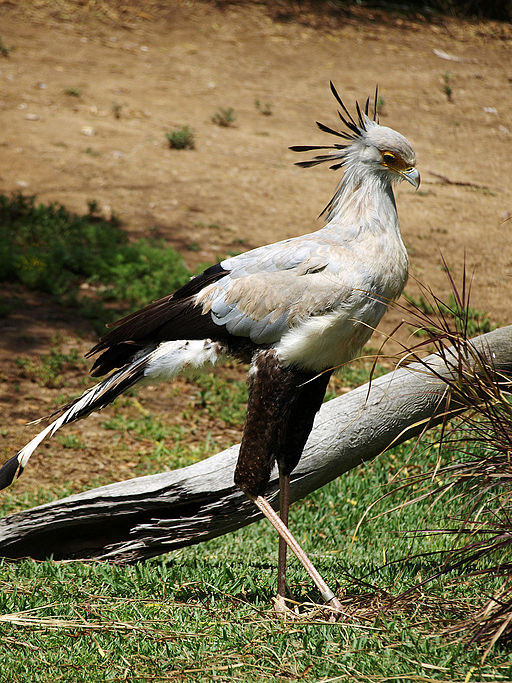The Secretarybird –Sagittarius serpentarius. The common name comes from the feathers of the head crest which resemble quill pens. Sagittarius, from the Latin, means “arrow or archer” and refers to the way an archer walked while stalking prey; serpentarius means “serpent handler” from the bird’s supposed affinity for snakes. They are endemic to Africa where they inhabit open areas.

A very distinctive and unmistakable bird, Secretarybirds stand approximately 4.3-4.9 feet tall, one of the tallest birds of prey in the world. Their lengthy, slender legs are longer than their thighs, giving them a somewhat stilt-like appearance. Their legs are, in fact, almost twice as long as other ground-dwelling birds of the same weight. The plumage is predominantly gray with black feathers on the wings and upper legs. The head has a crest of long black feathers that resembles a secretary’s quill pen, which gives the bird its name. Adults have a naked red-orange face with pale brown eyes and a yellow cere (the fleshy part of the beak containing the nostrils.) Their neck and head are not especially long, so the bird must stoop down to reach the ground. In flight the Secretarybird’s neck and legs are extended. The Secretarybird is related to other major groups of predatory birds such as the hawks and eagles, vultures, and the Osprey.
Secretarybirds are formidable hunters, primarily preying on small mammals, insects, and occasionally birds. Although known for eating snakes, especially the venomous cobra and adder, these reptiles do not comprise much of the bird’s diet. Occasionally the birds will take larger prey like rabbits and even young antelopes. The birds are diurnal, meaning they are most active during the day. They hunt by walking through the grasslands, savannas, or agricultural fields, using their strong legs and feet to stamp on the ground, flushing out prey hiding in the vegetation. The toes are so short and stout that the bird cannot use its feet and claws to grasp prey as many predatory birds do but once the prey is exposed, the bird uses its long legs and sharp talons to deliver deadly kicks, stunning or killing the victim before consuming it. The long legs allow it to apply a force to an imprisoned prey item of five times the bird’s body weight! Secretarybirds typically swallow their prey whole although larger animals will be held down by the feet and torn apart by the sharp bill.
Secretarybirds are usually found in pairs during the breeding season but sometimes gather in small groups, especially where food is abundant. They are known for their impressive courtship displays, which involve aerial shows, soaring high above the ground with an undulating flight. They build large, flat nests made of sticks and vegetation at the top of a thorny tree like an acacia to protect the eggs from predators; both male and female share the parental duties. In 2020 the International Union for Conservation of Nature designated the Secretarybird species as endangered as grasslands are being taken over by woody shrubs, fragmented by roads, and overgrazed by livestock.
We saw courtship of secretary birds in Kenya this summer, the pair hopping and pouncing on each other in their big stick nest atop a tree. Love your write ups!